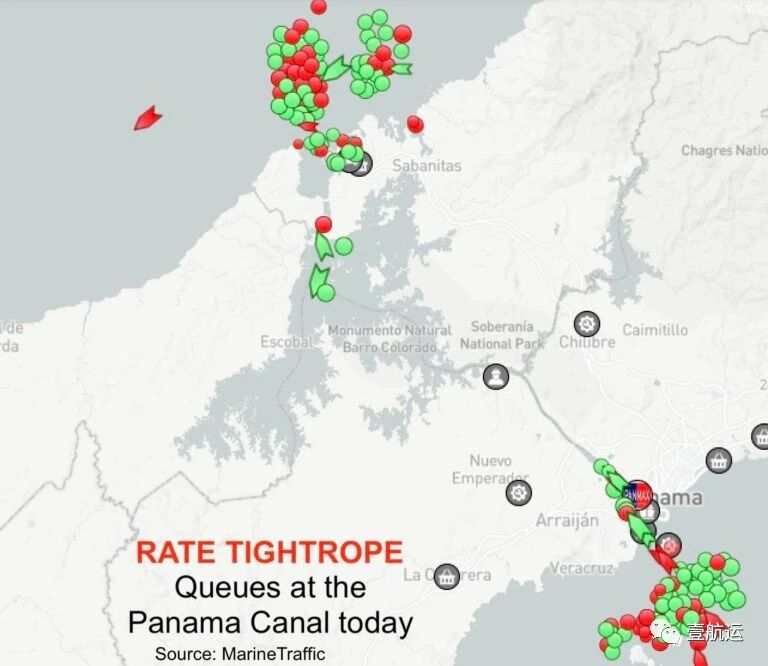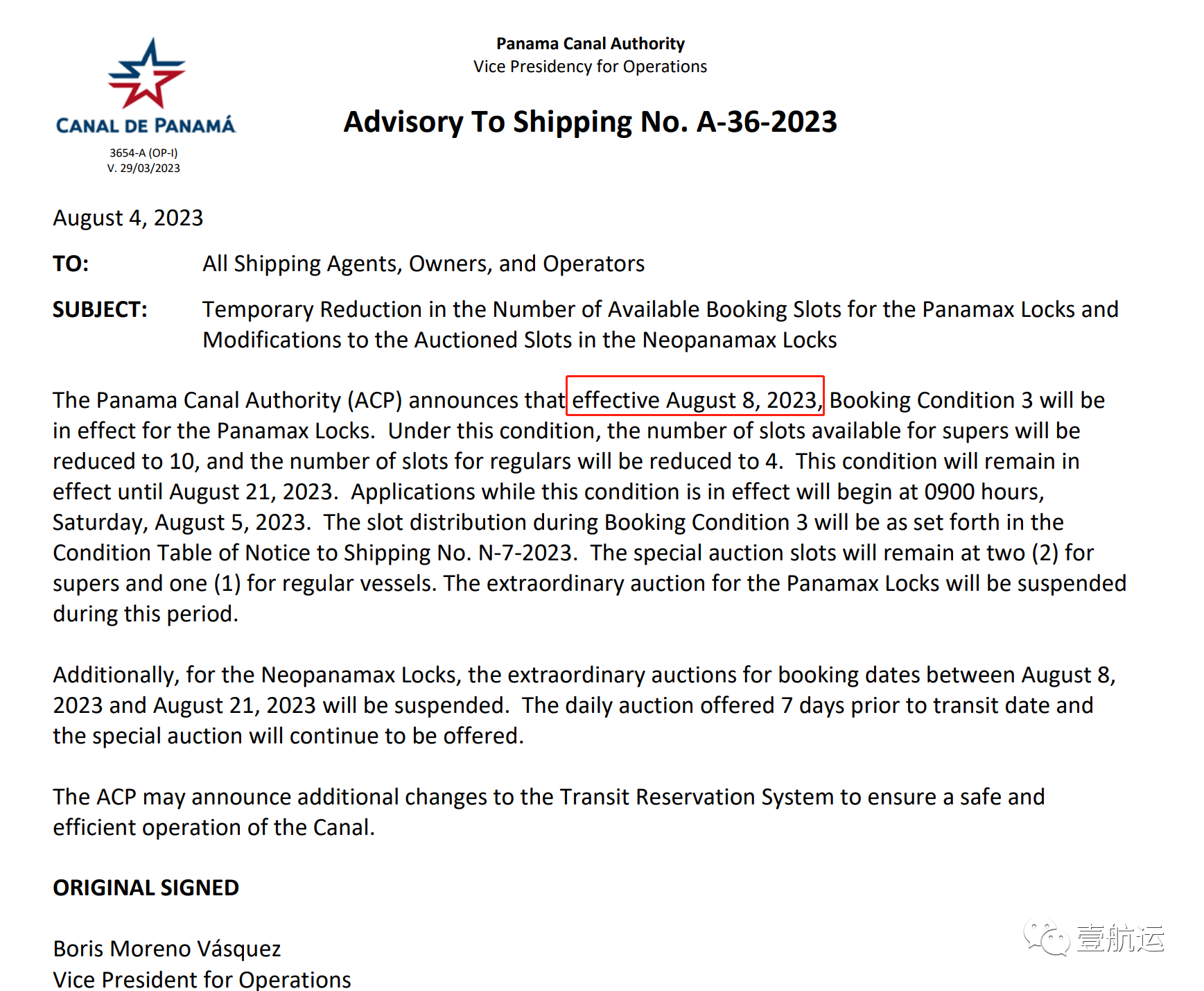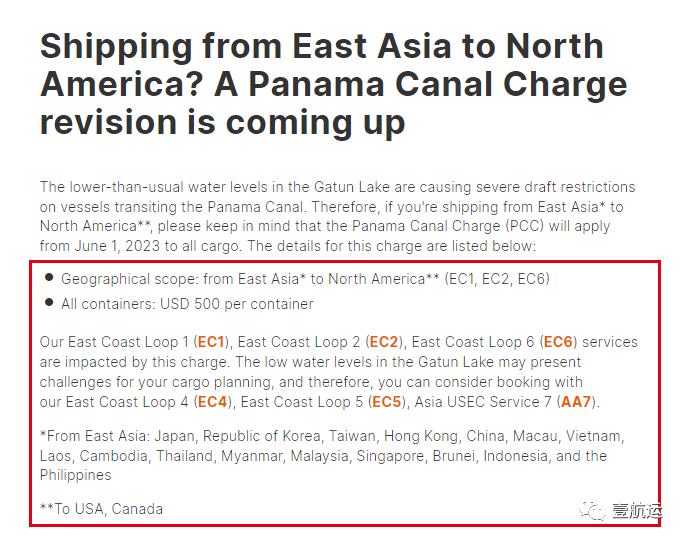全球航运大动脉--巴拿马运河正在遭受自1950年有记录以来前所未有的干旱枯水,这除了导致巴拿马运河通行能力大幅下降之外,也导致途径巴拿马运河集装箱船舶面临越来越严重的延误!
数据显示:在8月的第一周,每艘船在巴拿马运河的平均延误时间已经高达15至19天!
据了解,受“前所未有”的干旱影响,巴拿马运河管理局将其新巴拿马型船闸的最大吃水深度减少了约2米,并将每日船舶最大过境次数减少了20%--从7月30日起,将运河每日通过的船舶数量,从36-38艘下调至32艘。

运营条件的变化导致所有航段的船舶都面临延误,船舶跟踪数据显示,巴拿马运河两岸等待通过的船舶已经排起了长龙!

“巴拿马运河的延误提醒人们迫切需要解决气候变化问题。航运业是受气候变化影响最脆弱的行业之一,我们需要采取行动减少排放并减轻风险,”干散货船东和运营商Sagitta Marine的董事总经理Thomas Zaidman评论道。
虽然巴拿马已经恢复降雨,但当局不太可能在短期内对草案或过境数量进行任何上调,因为今年的El Niño天气现象会在今年晚些时候给该国带来更干燥的天气。
事实上,运河管理局已经承认,如果情况持续下去,明年可能会损失高达2亿美元的收入。

据悉,受运河枯水以及通过能力大降的影响,上周,长荣海运旗下一艘船名为Ever Max轮、运力为17312Teu的集装箱船在通过巴拿马运河时,不仅支付了150万美元的通行费,还被迫在巴尔博亚港(Balboa)卸载1400 Teu货物,以满足巴拿马运河13345 Teu的最大吃水限制。
运价平台Xeneta的首席分析师Peter Sand表示:“巴拿马运河目前确实是集装箱航运市场的不确定因素,因为它可能会对运费和美国从远东的进口产生潜在影响。”
另据货运代理Flexport Inc.的海运主管Nathan Strang称,运河吃水限制将使大多数船公司集装箱船上可用舱位大幅减少,这意味着运送同样数量的货物将需要更多的船只,这可能会增加船只等待通过的排队时间。
Strang表示,一些托运人将不得不把较重的货物分成两个集装箱,而不是一个,运载较重货物的船只受到的影响更大。他说,这些措施可能会使通过巴拿马运河的进口商和零售商每个集装箱额外增加1500美元的成本。

据一份报告称,由于每天过境的船舶数量有限,运河管理局建议船东提前申请通过运河的时间段,此举意味着很快他们就必须参加过境时段的“拍卖”,而这些拍卖价格一直都超过35万美元。
达飞轮船 (CMA CGM) 和赫伯罗特 (Hapag-Lloyd) 等集装箱航运公司已对运河限航和拥堵做出反应--加收附加费!增加了每标准箱 300 美元至 500 美元不等的运河附加费。
船公司征收巴拿马运河附加费
达飞轮船宣布分别自6月1日和9月1日,连续加征收巴拿马运河附加费PCC(PANAMA CANAL CHARGE),每次涨幅300美元/箱,具体收费标准如下:

5月份,赫伯罗特发布通知称,由于加通湖(Gatun Lake)的水位低于正常水平,对通过巴拿马运河的船只造成了严重的吃水限制。因此,从2023年6月1日起,针对从东亚运输到北美的所有货物征收巴拿马运河附加费PCC(PANAMA CANAL CHARGE)。
有关收费的详情如下:


严重的干旱迫使巴拿马运河推出航运限制措施,这些措施不仅意味着集装箱船想要通过巴拿马运河必须减轻装载并支付更高的费用,更预计今年夏天通过巴拿马运河运输货物的成本将进一步上升,货物也或将面临延误。
来源:壹航运